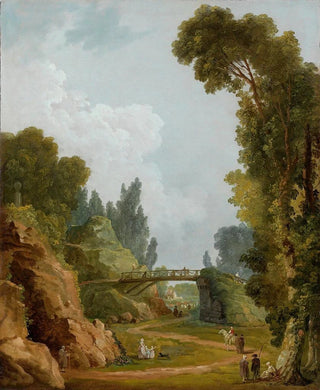Art print | The Rustic Bridge Château de Méréville France - Hubert Robert


View from behind

Frame (optional)
Reproduction of The Rustic Bridge at Château de Méréville, France - Hubert Robert – Captivating Introduction
In the panorama of art history, certain works stand out for their ability to capture the essence of a place and a moment. "The Rustic Bridge at Château de Méréville, France" by Hubert Robert is one of those creations that invites a visual and emotional journey. This painting, both peaceful and evocative, transports us to a romantic garden where nature and architecture blend harmoniously. The scene depicts a rustic bridge, a symbol of simplicity and authenticity, which seems to whisper forgotten stories. Through this artwork, Robert offers us a window into a world where time appears suspended, an invitation to contemplation and escape.
Style and uniqueness of the work
The strength of "The Rustic Bridge at Château de Méréville, France" lies in Hubert Robert's unique style, which combines realism with a touch of poetry. The artist excels in playing with light and shadow, creating an almost dreamlike atmosphere. The colors, delicate and nuanced, evoke the subtleties of a bucolic landscape, while the architectural details of the castle in the background add depth to the composition. The use of perspective guides the viewer’s eye through the painting, inviting exploration of every corner of this haven of peace. The presence of the bridge, a central element of the work, symbolizes the connection between man and nature, a theme dear to the artist who seeks to celebrate the beauty of the world around him.
The artist and his influence
Hubert Robert, often nicknamed the "painter of ruins," left his mark on his era with his distinctive artistic vision. Born in Paris in the 18th century, he was influenced by neoclassical and romantic currents but developed a style that is uniquely his own. His passion for gardens and landscapes allowed him to create works that transcend the simple pictorial frame, inviting the viewer to feel a deep connection with nature. Robert was also a pioneer in using ruins as motifs, transforming architectural elements into symbols of fleeting beauty.

Matte finish

View from behind

Frame (optional)
Reproduction of The Rustic Bridge at Château de Méréville, France - Hubert Robert – Captivating Introduction
In the panorama of art history, certain works stand out for their ability to capture the essence of a place and a moment. "The Rustic Bridge at Château de Méréville, France" by Hubert Robert is one of those creations that invites a visual and emotional journey. This painting, both peaceful and evocative, transports us to a romantic garden where nature and architecture blend harmoniously. The scene depicts a rustic bridge, a symbol of simplicity and authenticity, which seems to whisper forgotten stories. Through this artwork, Robert offers us a window into a world where time appears suspended, an invitation to contemplation and escape.
Style and uniqueness of the work
The strength of "The Rustic Bridge at Château de Méréville, France" lies in Hubert Robert's unique style, which combines realism with a touch of poetry. The artist excels in playing with light and shadow, creating an almost dreamlike atmosphere. The colors, delicate and nuanced, evoke the subtleties of a bucolic landscape, while the architectural details of the castle in the background add depth to the composition. The use of perspective guides the viewer’s eye through the painting, inviting exploration of every corner of this haven of peace. The presence of the bridge, a central element of the work, symbolizes the connection between man and nature, a theme dear to the artist who seeks to celebrate the beauty of the world around him.
The artist and his influence
Hubert Robert, often nicknamed the "painter of ruins," left his mark on his era with his distinctive artistic vision. Born in Paris in the 18th century, he was influenced by neoclassical and romantic currents but developed a style that is uniquely his own. His passion for gardens and landscapes allowed him to create works that transcend the simple pictorial frame, inviting the viewer to feel a deep connection with nature. Robert was also a pioneer in using ruins as motifs, transforming architectural elements into symbols of fleeting beauty.






